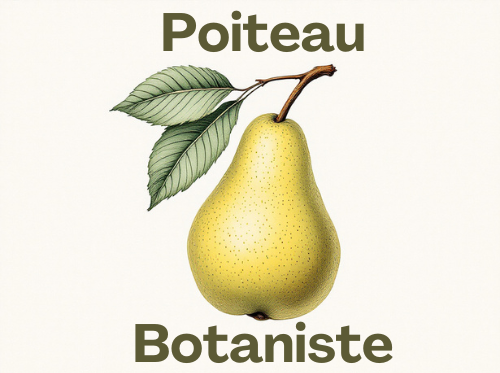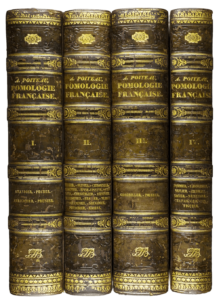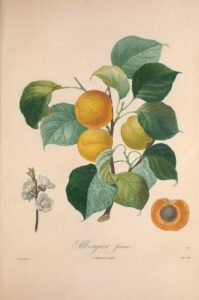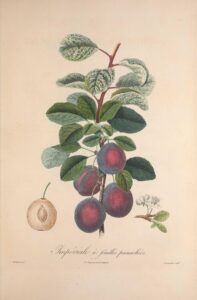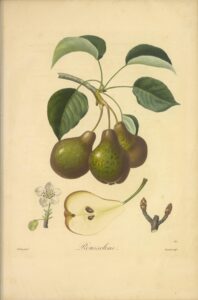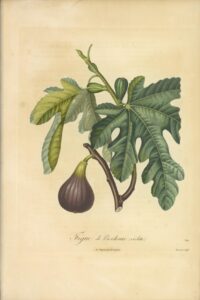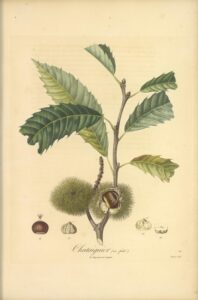Introduction
Published in 1846, ‘Pomologie Française : Recueil de plus beaux fruits cultivés en France‘ is a masterful work by Pierre-Antoine Poiteau , devoted to the study and illustration of fruits cultivated in France. This masterpiece of botanical literature combines scientific rigor and illustrative art, offering a detailed description of fruit varieties while highlighting the excellence of 19th-century French horticulture.
Thanks to more than 400 plates illustrated with great precision, this work remains an essential reference for botany enthusiasts, historians of fruit heritage and lovers of naturalist art.
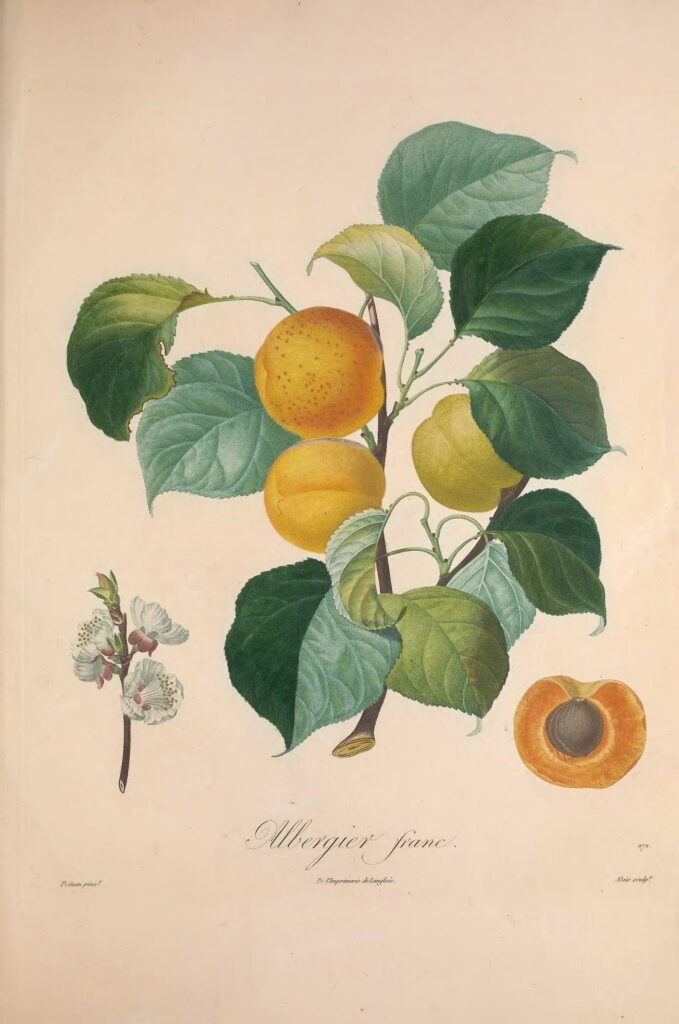
( Photo credit: Biodiversity Heritage Library)
A project born from a broader ambition
The work Pomologie Française was born from a broader ambition, dating back to the beginning of the 19th century. The idea of a pomological library germinated in 1807, during the creation of the Traité des arbres fruitiers, the fruit of the collaboration between Poiteau and Turpin . This initial project aimed to gather and organize knowledge about fruits, but the revolutionary turmoil forced Poiteau and Turpin to interrupt the publication of their Traité in 1815. This interruption, which lasted about fifteen years, led to the loss of some of the materials intended for pomology.
Despite these difficulties, Poiteau’s passion for horticulture and botany remained intact. Once the publication of the Traité des arbres fruitiers was completed, he finally resumed his initial project of a pomological library by publishing Pomologie Française in 1846. This work, a true tribute to fruit diversity, brings together more than 400 plates illustrating the most beautiful fruits cultivated in France, accompanied by detailed descriptions.
Pomologie Française demonstrates Poiteau’s expertise as a botanist, horticulturist, and artist, and is a valuable source of information on fruits and their cultivation in the 19th century.
A reference work for knowledge of fruits
Pomologie Française is distinguished by:
🌿 A careful classification of fruits : Poiteau precisely describes the characteristics of each variety, including their shape, color, texture and taste.
🎨 Exceptional botanical illustrations : The book’s plates, of remarkable finesse, bear witness to the excellence of the work of 19th-century illustrators.
📜 A historical account of fruits grown in France: Pomologie Française provides a better understanding of old varieties, some of which have now disappeared or evolved.
Illustrations: an artistic and scientific heritage
One of the most remarkable aspects of Pomologie Française is the exceptional quality of its lithographed plates . These illustrations are not mere representations, but true works of art, produced with scientific precision.
Poiteau, a botanist and illustrator himself, was able to faithfully transcribe the nuances of the fruits, making the work as beautiful as it is informative. Today, these illustrations are sought after by collectors and are exhibited in museums and specialized libraries.
( Photo credit: Antiquariaat Junk, Biodiversity Heritage Library)
A work that is still relevant today
Although published almost two centuries ago, French Pomology remains highly relevant:
🍏 In varietal conservation : It constitutes a valuable basis for arboriculturists and researchers working on the preservation of old fruit varieties.
📚 In historical and scientific research : It offers a detailed vision of horticultural practices of the 19th century.
🎨 In art and botanical heritage : His plates are still used as a reference for illustrators and botanical art enthusiasts.
Turpin’s name and the hypotheses about his absence
An intriguing element of Pomologie Française is the absence of Pierre-Jean-François Turpin ‘s name from the illustrated plates, even though he had collaborated with Poiteau on earlier works. Several hypotheses may explain this removal:
- A question of copyright : At that time, editorial and legal conventions regarding the attribution of illustrations were different from those of today. If the plates were created from pre-existing drawings but reworked under Poiteau’s direction, his name could legally be the only one mentioned.
- A reappropriation of the project by Poiteau : After the publication of the Traité des arbres fruitiers, Poiteau took up alone the initial ambition of a pomological work. On the other hand, for Pomologie Française, the texts (previously written by Poiteau) were reworked and the plates were reorganized by type of fruit. These profound reworks may explain the absence of the name of his former collaborator.
It is important to note that Poiteau retained a deep respect for Turpin. In his Cours d’Horticulture , published a few years later, he paints a glowing portrait of his former study companion, highlighting his talent and his contributions to botany. This testimony shows that Turpin’s absence from Pomologie Française was probably not a result of a desire to erase him, but rather a change in the conditions of publication and the production of illustrations.
Conclusion: A Heritage to Rediscover
Pierre-Antoine Poiteau’s Pomologie Française is much more than a scientific work; it is a true cultural and botanical heritage that continues to inspire and fascinate.
Whether you are a botanist, a lover of ancient fruits, or passionate about horticultural history, this work constitutes an essential gateway to the teeming world of French pomology.
🌱 Explore this heritage and let yourself be seduced by the beauty and richness of French fruits! 🍎🍐🍑
You can admire all the illustrated plates of this work on the
Biodiversity Heritage Library Flickr account :
📖 Also read: Discover Poiteau’s other major works, such as Histoire Naturelle des Orangers, and Traité des arbres fruitiers, nouvelle edition
